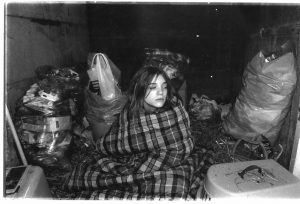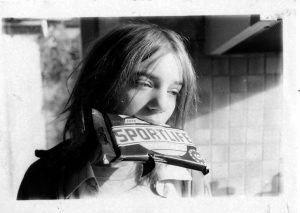Florian Bijloos
Fotowerken
09.03.2014 — 20.04.2014
[NL]
In 2006, als coördinator van de vzw artis, een organisatie die zich bezighoudt met een artistiek programma voor voormalige psychiatrische patiënten, heb ik Erik Thys voor het eerst ontmoet. Als psychiater van het PSC in Elsene had hij plannen om in een tuinhuis een vereniging op te richten, later KAOS genoemd, met een gelijkaardige opdracht als die van de vereniging waar ik toen voor werkte. Tijdens ons gesprek toonde hij mij voor het eerst fotografisch werk van Florian Bijloos.
Twee jaar later heb ik een drietal foto’s van de kunstenaar geselecteerd voor de allereerste tentoonstelling van LLS 387, waarvoor ik ongeveer 180 kunstwerken verzamelde. “Vanaf Nu!…” werd ingericht door Ricardo Brey en Willem Oorebeek en ik herinner mij een bijzonder moment toen we tijdens de opbouw met ons drieën de foto’s van Florian Bijloos bekeken en even stil werden, aangegrepen door hun kwaliteit en uitdrukkingskracht.
Meer dan vijf jaar later, voor een tentoonstellingsproject op zoek naar kunst die mij dichter bij de realiteit zou kunnen brengen en die mij zou kunnen overtuigen van een relevante bijdrage op sociaal maatschappelijk vlak, herinnerde ik mij de fotowerken van Bijloos en konden deze een antwoord bieden op al mijn twijfels en vragen.
Omdat de kunstenaar door omstandigheden de presentatie van zijn werk hier in LLS 387 niet zelf kon verzorgen, heb ik met veel aandacht – bijgestaan door Erik Thys en de kunstenaars Ria Pacquée en Wim Catrysse – een selectie uit zijn omvangrijk oeuvre gemaakt. We richtten onze aandacht vooral op die foto’s die een soort persoonlijk archief vormen en die dus op een heel directe manier zijn eigen leefomgeving weergeven: vrienden, familie, zijn verblijfplaatsen, de keukentafel enz.
Omdat Florian Bijloos soms minder greep heeft op zijn mentale conditie, d.w.z. dat zijn levensloop gepaard gaat met meer ups-and-downs, wil dat nog niet zeggen dat we niet zijn lotgenoten zijn, want zijn wereld is ook die waarin wij leven. En de tederheid en het respect en ook de afwezigheid van voyeurisme, kortom de manier hoe Bijloos als kunstenaar de wereld om zich waarneemt en in zijn werken vasthoudt, laat ons het leven omarmen ondanks – of juist omwille van – datgene wat hij zichtbaar maakt.
Florian Bijloos is geboren in 1978 en leeft sinds enkele jaren in Antwerpen. Begin jaren 2000 heeft hij een opleiding fotografie gevolgd, waar hij zich de techniek en het labowerk van de analoge fotografie eigen maakte. De foto’s zijn ontstaan in de periode tussen 2000 en 2006. Zijn werk werd getoond in Art en Marge te Brussel en in Galerie Duende in Mechelen en is geïntegreerd in het glasraam van de kapel van het PSC St.-Alexius te Elsene. Sinds 2006 richt zijn artistieke expressie zich op het schrijven.
Ulrike Lindmayr, maart 2014
Met dank aan Bert Bijloos, Nadia Bijl, Martin Blank, Wim Catrysse, Yirka De Brucker, Andrea Kränzlin, Ria Pacquée, Erik Thys, Sietske Van Aarde en KAOS (vzw Brussel).
De tentoonstelling werd in samenwerking met vzw KAOS (Brussel) geproduceerd.
Met de structurele ondersteuning van de Vlaamse overheid.
Gesponsord door Duvel Moortgat.
[EN]
It was in 2006, when I was coordinator of ‘artis’, a not-for-profit organization engaged in developing artistic workshops for former psychiatric patients, that I first met Erik Thys, a psychiatrist at the Psycho-Social Centre in Elsene (Brussels). Thys was planning to turn a garden house into a centre for a new association – later called the KunstAtelier OpperStraat or KAOS – whose mission was similar to that of the organization for which I was working. It was during our conversation that I had my first glimpse of the photographic work of Florian Bijloos.
Two years later the very first exhibition at LLS 387 was held, for which I brought together around 180 works of art, including three of Bijloos’s pictures. That show, Vanaf Nu!, was presented by Ricardo Brey and Willem Oorebeek and I well remember the extraordinary moment during the installation when we looked at Florian Bijloos’s photos and all three of us were silenced by their quality and expressive power.
Some five years after that, when I was preparing an exhibition project and looking for art that could bring me closer to reality and convince me that it represented a relevant social contribution, I remembered Bijloos’s photographs and realized that these could provide an answer to all my doubts and questions.
Circumstances prevented Bijloos’s direct involvement in the presentation of his work and so, with great care and deliberation and helped by Erik Thys and artists Ria Pacquée and Wim Catrysse, I made a selection from his substantial oeuvre. We focused primarily on those pictures that form a kind of personal archive and which thus very candidly represent his own environment: friends, family, the places he’s lived in, his kitchen table etc.
Florian Bijloos may not always have complete control over his mental state – or put another way, he goes through more ups and downs that most of us – but that doesn’t mean that we don’t share his lot in life, for his world is the one we live in as well. And the tenderness and respect, as well as the absence of voyeurism – in short, the way in which, as an artist, Bijloos observes the world around him and absorbs it into his works – enable us to embrace life despite (or just because of) what he makes visible.
Florian Bijloos was born in 1978 and for the last few years he’s lived in Antwerp. In the early 2000s he studied photography, mastering the technique and developing of analogue photography. The pictures were taken between 2000 and 2006. His work has been shown in Art en Marge in Brussels and Galerie Duende in Mechelen and is integrated into the chapel window of the PSC Sint-Alexius in Elsene. Since 200, he has concentrated on writing as his medium of artistic expression.
Ulrike Lindmayr, March 2014
With thanks to Bert Bijloos, Nadia Bijl, Martin Blank, Wim Catrysse, Yirka De Brucker, Andrea Kränzlin, Ria Pacquée, Erik Thys and Sietske Van Aarde.
This exhibition has been produced in collaboration with KAOS (vzw, Brussels).
With the support of the Flemish Government.
Sponsored by Duvel Moortgat.



